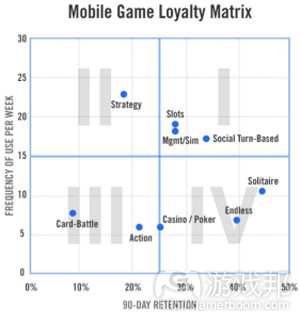多人游戏机制和比赛将提高手机游戏的用户留存
作者:Gabriel Cornish
随着手机游戏市场中的竞争性逐渐增强,在此争取成功变得越发困难;登上排行榜榜首之位也不再能够保证每个月的高收益了。随着更多高质量的新游戏的不断涌入,即使是最受欢迎的游戏也比之前承担着更大规模的玩家基础流失。结果便是,所有游戏的留存率都在下降,而最成功的游戏也在拖着盈利率和游戏终生价值往下走。
提高手机游戏留存率的一大方法便是引入多人游戏功能。在今天的市场上,单人游戏因为种种局限已经开始失去魅力了,如它们的游戏玩法要么就是不断重复着,要么就是基于内容长度而不断延伸。大多数单人手机游戏只能维持玩家至打败游戏,或直到他们厌倦了核心游戏机制。而多人游戏能够通过创造更具竞争性和社交性的内容而刺激玩家不断尝试游戏玩法。有些强调了多人游戏功能的手机游戏甚至延长了50至100小时的游戏寿命。
多人游戏能够带来社交氛围,并将游戏玩法带向一个全新的高度。随着团队合作和竞争机制不断出现在游戏中,玩家更加愿意频繁,投入且长时间地游戏。此外,玩家也会因为受到游戏的推动而将自己的朋友带入游戏中,彼此竞争,从而创造了一种免费且高质量的用户获取渠道。社交游戏能将一些具有共同兴趣的陌生人集中在一起,创造一种全新的关系并围绕着游戏组建社区。
多人游戏添加了一种全新的游戏局面,即培养了投资型玩家,他们更愿意生成利益并不愿意轻易退出游戏。举个例子来说吧,在《War Metal: Tyrant》中,宗族中的玩家的ARPU值是普通玩家的20倍,(游戏邦注:即《Tyrant》55%的收益是来自6%的宗族玩家)。你认为哪些玩家更会坚持玩游戏?
多人游戏本身可以通过比赛等实时活动而不断完善。比赛能培养时间限制所创造的竞争氛围。而竞争的即时性能够提高应用内部购买的可能性,并强化游戏玩法而提供更具有奖励性的体验。这不仅能够打破单一的内容为玩家创造全新的游戏体验,同时与周期性内容结合在一起也能够确保游戏的新鲜。游戏可以为比赛的胜者设置真实和虚拟的奖励,提供强大的动机促使他们参加更多比赛,特别是当比赛是基于获胜次数而非分数时。
就像图中显示的,如果开发者想要提高用户的忠诚度,那么他们就应该标准表中的I范围。在这一范围内,我们可以看到90天用户留存和使用频率的最高值。多人游戏机制和比赛如果是以普通的街机游戏为终点,那便有可能位于表中II和IV的范围内,但却能够向I范围的回合制社交游戏而转变。在图表中,范围I是最理想的位置,即同时拥有高使用频率和高用户留存率,《神庙逃亡》和《愤怒的小鸟》等大受欢迎的应用便属于这一范围。毫无疑问,多人游戏机制和比赛能够帮助游戏进入这一范围。
(本文为游戏邦/gamerboom.com编译,拒绝任何不保留版权的转载,如需转载请联系:游戏邦)
How Multiplayer and Events unlock higher retention and monetization in mobile games
by Gabriel Cornish
With competition in the mobile games market rising, success has become unstable; obtaining a place at the top of the charts no longer guarantees months of high revenue. With the steady influx of new, high-quality games being created, even the most popular games are seeing large portions of their player base leave, and faster than ever before. As a result, retention rates have sunk for all but the most successful games, dragging monetization rates and lifetime value down with them.
A proven method for increasing retention rates on mobile games is multiplayer features. Single player games are starting to lose steam in today’s market due to their limitations: their gameplay is either repeated ad nauseum or finite based on content length. Most mobile single player games only retain a player long enough to beat the game or grow tired of it’s core gameplay mechanic. Multiplayer provides the player with a feature that stimulates a desire for gameplay by making it more competitive and social. Some mobile games have seen multiplayer add another 50-100 hours to the game’s lifespan.
Multiplayer brings a social atmosphere that takes gameplay to a new level of intensity and excitement. With the teamwork and competition brought into the game, players are inclined to play more intensely, more often, and for longer sessions. Furthermore, players have incentive to introduce their peers to the game to compete against them, creating a free, high quality acquisition channel. Social gaming brings together strangers over a common interest, creating new connections and forming a community around the game.
Multiplayer adds a new dimension of gameplay that establishes invested players, who are more likely to generate revenue and are less prone to quitting. For example, in War Metal: Tyrant, players who are in clans have an ARPU 20 times higher than those who aren’t, with 55% of Tyrant’s revenue coming from the 6% of players that are in clans. And which players do you think play more and stick with the game?
Multiplayer itself can be further improved through live events such as tournaments. Tournaments foster a competitive atmosphere bracketed by a time limit. The immediacy of the competition increases in-app purchase likelihood and enhances gameplay to provide a more rewarding experience. The break in monotony becomes a refreshing experience for gamers and also can work together with seasonal content to keep the game feeling fresh. Real and virtual prizes can be set for the winners of the tournament, giving a strong incentive to participate and play more matches, especially if the tournament is based on number of wins rather than high score.
As you can see, developers should aim for quadrant I on the chart if they’re looking to maximize their user loyalty. In this quadrant we see the highest amount of 90-day retention and the frequency of use. What multiplayer and tournaments end up doing is taking a regular arcade game, which is most likely located in Quadrants II-IV in the shown graph, and transforming it into a social turn-based game found in Quadrant I. As shown in the graph, Quadrant I is the most ideal place to be, with both a high frequency of use and a high retention rate for its games, and is the home of popular apps such as Temple Run and Angry Birds. There is no doubt that multiplayer and tournaments significantly help a game reach that stage.(source:gamasutra)
下一篇:从不同层面分析游戏空间中的野地








































 闽公网安备35020302001549号
闽公网安备35020302001549号